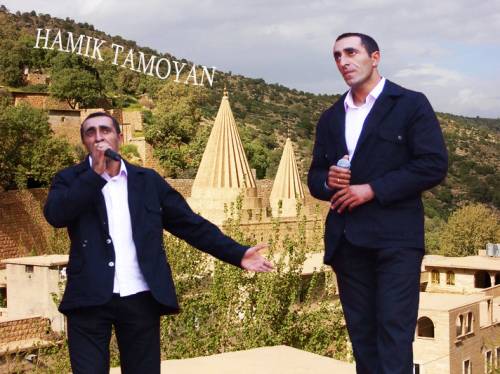Yezidis History
The main Ezide God is Mighty Khudeh that is the creator of the Universe. According to Ezide national rules, no representative of other nation can be called an Ezide. The version that the Ezides were Zoroastrians is wrong. Zoroaster was a religious preacher who was a Persian by origin and lived in 635 BC.
To relate Ezides to Yazats is also wrong. Yazat is an Old Iranian God that lived 3 000 years ago BC. There is no any reference between Ezides and the city of Yezd in Iran, as the Ezides never lived in that city. Remember that “Izdai” means I gave, and has nothing to do with the name Ezid.
Some identify Ezides with Kurds, which is also wrong. “Kurd” in some Iranian languages means ‘shepherd’. Kurds formulated as a nation in the X-XII cc, therefore they cannot have any connection with the Ezides. None of the above mentioned could be Red Sultan Ezide or has any reference to him. All of these versions have no historical background.
 |
| Red Sultan Yezid |
 |
| Sheikh Adi |
In the XI century during the reign of Shikhadi, the Ezides moved from Sham to Lalish, Shangal (Sinjar). After the death of Shekh Adi the same century, a great number of Ezides moved to the nearby areas of the cities of Western Armenia such as Kars, Mush, Van, Erzerum, in Diarbakr – Ortala, Karakuy, Igdir, Sink, Digor and other areas.
Though we have no State system or State organization and are spread all over the world, we have preserved our unique national features, for we have lived in strong communities and stayed attached to our religion and beliefs. Maybe this absence of State organizations was the reason that we were called differently in different countries: in Turkey they called us Turk-ezides, in Iraq – Arab-ezides or Kurd-ezides. And though we were considered to be Muslims, this fact didn’t prevent the some countries to organize genocides against the Ezide people.
 |
| The arch above the entrance to the 13th Century temple. It houses the tomb of a key Yezidi figure, Sheikh Adi, who died in 1162, but the roots of the Yezidi faith pre-date Islam and Cristianity |
 |
| Lalish (Main Sanctuary of the Yezidis) |
It’s a few years that we – Armenian-inhabited Yezides have got informed by means of media- TV, newspaper, magazines, video- that some Tahasin Beg, that considers himself a Mir of the whole world, announces that Yezids are Kurds and their language is Kurdish.
We – Armenian-inhabited Yezids consider such a person to be a traitor to a long-suffering people and it’s millions of descendants. We don’t recognize him as a Mir of Yezids. If he were a Mir of Yezids then why hadn’t he at least once visited Armenian Yezids and also the Yezids in the area of the former Soviet Union. We ourselves consider a Mir the Ismail’s grandson, Masoi’s son Anouchar, as soon as both Mir Ismail and his sons and grandsons visited us at our place.
Double the national hero of the Yezidis
The President of the National Unity of Yezidis of the World
















4 comments:
So what is the Yezidi Language? What Language do they speak?
Language Yezidis (ezidiki) belongs to the Iranian group of indioeuropean family.
After all, no coincidence that in the newspaper the National Union of Yezidis "Ezdihana" is written: "Nationality - Yezidi, language - the Yezidi, religion - Sharfadin. The Yezidis in 11 th century had its own alphabet of 33 letters were 2 Yezidi sacred books "Matuba Rash" and "Kteva Jalva, who wrote the Shekh Adi and Shekh Isn. Currently, the oldest alphabet does not apply. Now at the initiative of conductor Tamoyan Aziz and journalist Hasan Tamoyan created a new alphabet based on Russian and Latin letters.
Textbooks, newspapers, art books are being published on this alphabet.
New alphabet Yezidis - Alifba Ezdiki.
Search for ur roots in prevedic India. Adinath Aadishwar, Shiva, Bharat, Nirgrantha, Gymnosophists.....but remember Non-violence is at the base of Ancient Indian civilisation.
Post a Comment